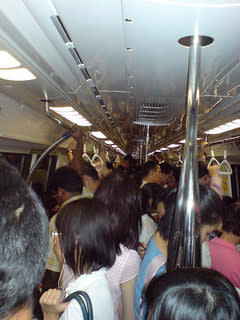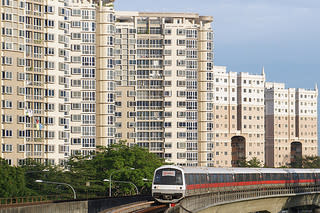How Exactly Do MRT Stations Affect Your Property Value?
MRT stations raise surrounding property value, we all know that. The main question is how. As in how much and how soon. Because contrary to popular belief, MRT stations aren’t metaphorical Jackpots that just aligned three fruit. Nor are you an overnight property tycoon just because you see trains out the window. Here’s a look at how MRT stations actually impact your property price:

“And I’d like the staff to dress better next Tuesday, that’s when the buyers will be viewing.”
1. Values Rise After Construction, Fall During Construction
Sellers tend to raise their expectations when a MRT station’s announced. This often results in a momentarily higher asking price, a painful realization that no one cares, and then a reversion to normal prices.
This is different from sellers who raise prices after the station’s operational. Those guys can raise prices and be taken seriously.
So what causes this big difference? The answer is rent. I spoke to property investor Charlie Sng, who was flipping houses when Velcro diapers were still a new concept:
“During construction of the station, there is a lot of noise and dust. Also, the roads around the area tend to become more congested.
The construction might take a few years. A tenant who is looking to stay for, say, two years…might never experience the benefit of the MRT station. She will only suffer the inconvenience. This can cause the rental value of the property to fall quite significantly, until after the construction.”
MRT? No, no, that’s the projected HDB flats in 2030.
How much does it fall by?
“It depends on how bad the congestion is, and the area in general. If I had to guess, I would expect at least 10% to 20% drop in my rental income.”
In summary: Most property values fall during the station’s construction, and rise after the station’s operational.
2. Buyer Demographics
Okay, let’s say the MRT station’s fully operational (as “fully operational” as SMRT can make anything these days).
That means money, right? So now your asking price can match the Israeli defence budget. Well hold on to your horses. According to Charlie, not all buyers consider MRT stations to be relevant:
“In wealthier areas, the presence of a MRT station has quite a minimal impact.
This is one reason I was not too excited about the Thompson line. Most of the people who want to live there can probably afford a car. In fact, one of my acquaintances staying there actually complained about the new line. He was afraid it would cause his property value to drop, because of possible noise pollution.
I think he’s exaggerating the problem, but you see my point. To an owner-occupier who can afford an upmarket property, who probably has two or more cars…why would he care whether there’s a train station nearby?”

In conclusion, anyone who can afford this house AND a car will probably end up in jail.
However, the opposite is true for mid-range properties, and for some landlords:
“Many of my tenants are foreign students or short-term workers. Most rely on public transport, so they are quite happy to pay more to be near the station. So as a landlord, I would accept a higher asking price. As an owner occupier, I drive so I’m not as interested in the station.”
(PS: For more on being a landlord vs. an owner occupier, follow us on Facebook).
3. It Depends on The Train Line
If the line doesn’t go straight to key employment zones (e.g. Raffles Place, Tanjong Pagar), the station may not add as much value as you think. Charlie says:
“Not all train stations are equally prized. Generally, MRT stations contribute the most to market value when they go direct to key employment zones.
Take a key employment area like Raffles Place. If you work there, and the station near your house is on the Circle Line, it can take you a long time to get to work anyway. It might be faster to just walk to a bus stop and take the bus.”
So now you know why certain MRT stations contribute more to appreciation than others.
4. The Exact Distance to the Train Station Matters
“And the train station’s really convenient. Assuming you found your NS route march easy.”
Property developers use the term “within walking distance” very loosely.
In some cases, “within walking distance” means “if you’re the sort who likes walkathons, and thinks 15 minutes uphill is pleasant and invigorating.”
Charlie tells me that:
“Property close to a MRT station carries a price premium, often around 15%. But the question is how close is ‘close’?
You try to walk to the station yourself. If it’s really easy, you can do it in five minutes or less, then yes…it’s something that many buyers might pay for. But if it takes 15 minutes to walk, some buyers will tell you that, to them, it doesn’t count as being close.
I find this is true with older buyers, those in their 50′s or above. To many of them, 10 minutes uphill walk means the station is still inconveniently located. They cannot accept your higher asking price.”
5. Is It Already Priced In?
“And the train was about $1.2 million, so we went ahead and added it to the sale price.”
URA’s (Urban Redevelopment Authority) master plan is open to the public. As such, most property developers already know where the MRT stations will be. They’ll go out of their way to buy land close to these areas.
Some pretty absurd amounts are bid for these plots. As such, the sale price of any eventual development will already “price in” the future train station. Just look in those condo brochures: Some already advertise “future site of XYZ train station”, even if said station is still three squiggles on a drawing board.
Charlie mentions that:
“For such new developments, the price already includes the amenity of the train station. Even after the station is operational, there may not be further appreciation due to the station being there.”
And don’t forget: MRT station or no, get the cheapest loan. That’s the best way to see capital gains. Visit sites like SmartLoans.sg for more on that.
Image Credits:
jakrapong, yuhui, kenteegardin, nSeika, alantankenghoe, (Thumbnail) Dave Q
Did an MRT station help your property? Comment and let us know!
Get more Personal Finance tips and tricks on www.MoneySmart.sg
Click to Compare Singapore Home Loans, Car Insurance and Credit Cards on our other sites.
More From MoneySmart

 Yahoo Finance
Yahoo Finance 


